
11 Most Endangered Historic Places
China Alley
When Chinese immigrants arrived in 1877 to the newly established San Joaquin Valley town of Hanford, Calif., they found themselves in an unfamiliar place with no reminders of home, facing cultural barriers and often out-right racism. Despite segregation and oppression, the Chinese community in Hanford flourished and developed a vibrant Chinatown, known as China Alley, which soon boasted restaurants, herb stores, laundries, gambling houses, grocers and a Taoist temple—all constructed of local California redwood and brick fired on site. A short, densely lined street, China Alley was a vibrant hub where immigrants met to talk politics, share a meal, read Chinese newspapers and play mah-jong. Reaching its peak in the pre-World War II years, China Alley increasingly served a more diverse population, especially as racial barriers were challenged and eased.
Through the ensuing years, the Chinese population in Hanford declined. Although the Taoist Temple Preservation Society completed a stunning renovation of China Alley’s temple in the early 1970s, the organization does not have the financial resources to acquire and rehabilitate all the buildings along China Alley.
Sadly, on May 12, 2021, the Taoist Temple Museum in the China Alley Historic District was heavily damaged by fire that started on the front staircase, which is also the main entrance to the temple. The building itself did not sustain structural damaged from the fire. While the building is stable, the fire caused severe heat and smoke damage to the temple room and its artifacts on the second floor, which will require significant clean up and conservation.
As of May 2024 significant strides have been made to catalog and separate items that would remain in Hanford, and items that were moved to climate-controlled conservation facilities in San Francisco, Los Angeles, and Northern California. Conservators are working on the couplets (forms of literature and poetry often placed on the front of temples), objects, and paper items. Several lanterns and the main Altar are currently being conserved with remarkable success.
In addition to object conservation an architect specializing in historic buildings has been working with a structural engineer to draw up reconstruction plans. Contractors have shored up the first and the second stories. The burned stairway and the bearing wall the stairs were attached to was removed, while the tongue and groove first floor ceiling was removed in the burned area to assess the floor joists of the second floor. While more funds will be needed to fully restore the site, progress is slow and steady.
China Alley was included on the National Trust's 11 Most Endangered Historic Places list for 2011.
Stay connected with us via email. Sign up today.
Related Stories
-
America's Chinatowns Welcome to America's Chinatowns: The Artists -
America's Chinatowns Welcome to America's Chinatowns: The Advocates -
America's Chinatowns Welcome to America's Chinatowns: The Storytellers
Explore More Places
The Mother Road turns 100 years old in 2026—share your Route 66 story to celebrate the Centennial. Together, we’ll tell the full American story of Route 66!
Share Your Story



